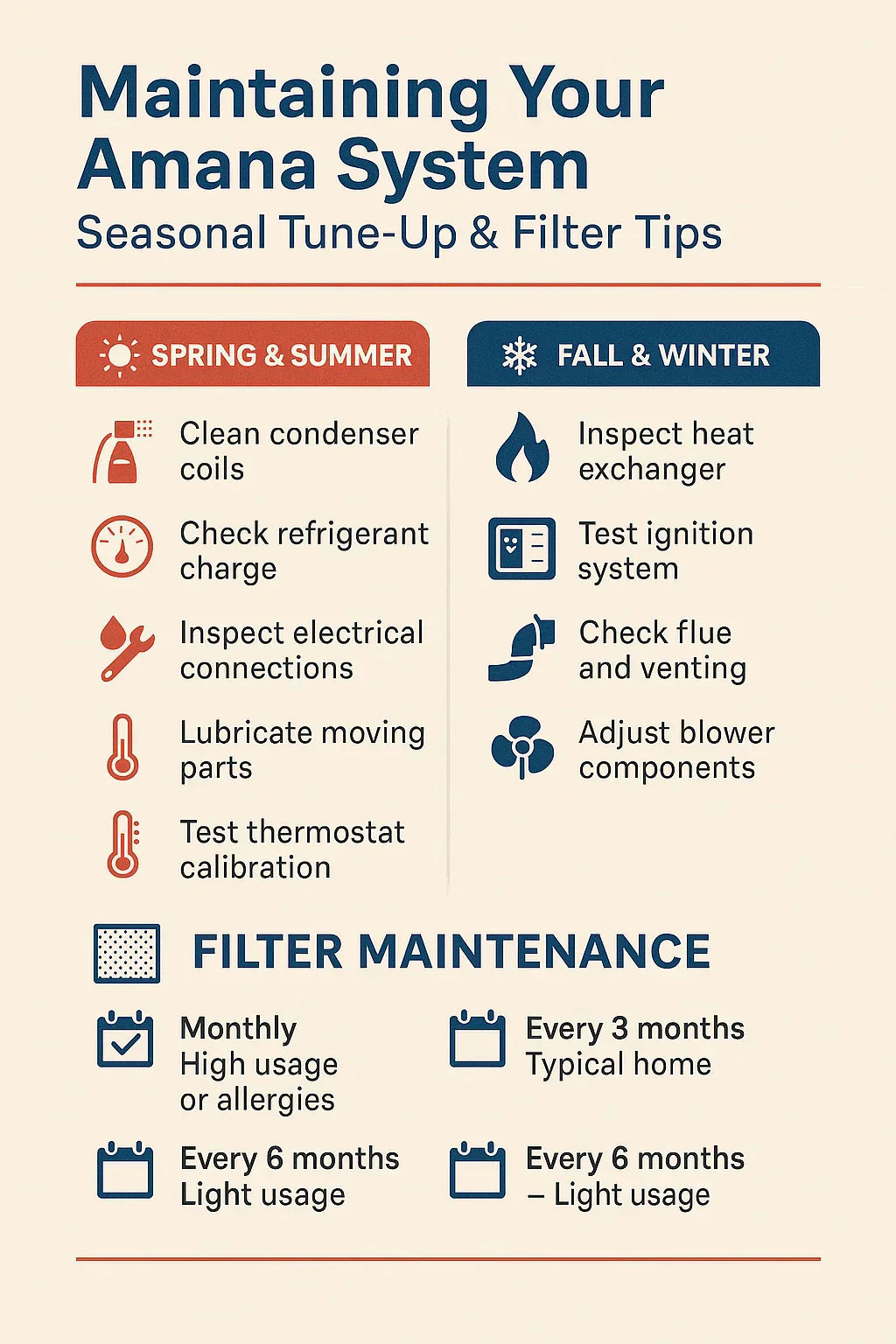🏠 Introduction: Why Seasonal Maintenance Matters
Your Amana HVAC system is one of the hardest-working appliances in your home. It cools your house in the blazing summer, keeps it warm in the depths of winter, and runs quietly in the background year-round — until it doesn’t.
Seasonal maintenance is the key to:
-
Avoiding costly breakdowns
-
Maintaining high efficiency (lower energy bills)
-
Extending system life by years
-
Protecting your warranty coverage
Amana’s Lifetime Unit Replacement Warranty (on select models) requires that maintenance be performed according to manufacturer recommendations — and documented by a licensed professional (Amana Warranty Details).
This guide will walk you through what to do each season, filter care best practices, and pro tips to keep your system running like new.
🛠 Spring & Summer Tune-Up Checklist
When warmer weather arrives, your cooling system is about to work harder. A spring tune-up prepares it for peak performance.
1. Clean the Condenser Coils
-
Remove leaves, dirt, and grass clippings from around the outdoor unit.
-
Gently rinse the coils with a garden hose (no high pressure).
-
Dirty coils can increase energy use by 30% (Energy.gov Coil Maintenance Guide).
2. Check Refrigerant Charge
-
Low refrigerant means reduced cooling capacity and potential compressor damage.
-
Only an EPA Section 608–certified technician can legally check and recharge refrigerant (EPA Section 608).
3. Inspect Electrical Connections
-
Loose wires or worn contacts can cause system failures.
-
Technicians will test voltage and tighten all connections.
4. Lubricate Moving Parts
-
Motors and fans run smoother, reducing wear and energy draw.
5. Test Thermostat Calibration
-
Ensures the system cycles on and off at the right temperatures.
-
Smart thermostats should have firmware updated for compatibility with Amana’s ComfortBridge™ controls.
🍂 Fall & Winter Tune-Up Checklist
When temperatures drop, your heating system takes the lead. A fall tune-up ensures safe and efficient operation.
1. Inspect Heat Exchanger
-
Look for cracks or corrosion, which can leak dangerous carbon monoxide.
-
Any damage should be addressed immediately.
2. Test Ignition System and Safety Controls
-
Modern Amana furnaces use hot-surface ignition — testing ensures reliable startup.
3. Check Flue and Venting Systems
-
Make sure there are no obstructions and all joints are sealed.
-
Venting must be free of debris and properly sloped.
4. Adjust Blower Components
-
Correct airflow ensures balanced heating and minimizes hot/cold spots.
🧾 Recommended Service Intervals
| Task | Homeowner Frequency | Professional Frequency |
|---|---|---|
| Replace/Clean Filter | Monthly–Quarterly | During seasonal tune-up |
| Outdoor Unit Cleaning | Monthly visual check | Spring |
| Coil Cleaning | Light rinse monthly | Deep clean annually |
| Refrigerant Check | — | Annually |
| Electrical Testing | — | Annually |
| Duct Inspection | — | Every 3–5 years |
📌 Savvy Tip: Set calendar reminders for both spring and fall to schedule professional service.
🫧 Filter Maintenance Tips
A clogged filter can increase energy use by 5–15% and cause early system failure
Types of Filters in Amana Systems
-
Disposable Pleated (Most Common) – MERV 8–13; replace every 1–3 months.
-
Washable/Reusable – Clean monthly; allow to dry completely before reinstalling.
-
HEPA Filters – High filtration; may require professional installation to avoid restricting airflow.
Choosing the Right MERV Rating
-
MERV 8–11: Good balance of airflow and filtration for most homes.
-
MERV 13+: Captures smaller particles but can strain older systems if not sized correctly.
How Often to Replace or Clean Filters
-
Every 1–2 months: Pets, smokers, allergy sufferers, or high pollen seasons.
-
Every 3 months: Light use and clean indoor environments.
📉 Common Mistakes to Avoid
-
Skipping Pre-Season Checks
Waiting until the first heatwave or cold snap can mean delayed service due to high demand. -
Using the Wrong Filter Size
An ill-fitting filter lets dust bypass and clog coils. -
Closing Too Many Supply Vents
Can increase system pressure and lead to duct leaks or blower damage.
💡 Efficiency Boosting Habits
-
Keep Outdoor Units Clear: Maintain at least 2 feet clearance on all sides.
-
Maintain Proper Humidity: Ideal indoor humidity (30–50%) improves comfort and efficiency.
-
Use a Programmable Thermostat: Save up to 10% annually by adjusting temperatures when you’re away (Energy.gov Thermostat Tips).
📌 Savvy Takeaway
Your Amana system is built to last — but only if you give it the care it needs.
-
Spring & summer: Focus on cooling efficiency — coil cleaning, refrigerant check, and thermostat tuning.
-
Fall & winter: Prioritize safety — heat exchanger inspection, vent checks, and ignition system tests.
-
Year-round: Keep up with filter changes and clear airflow paths.
Bottom line: A professional seasonal tune-up is an investment that pays for itself through lower energy bills, fewer repairs, and longer system life.
In the Next topic we will read more about: Troubleshooting Your Amana HVAC: Common Issues & How to Fix Them







